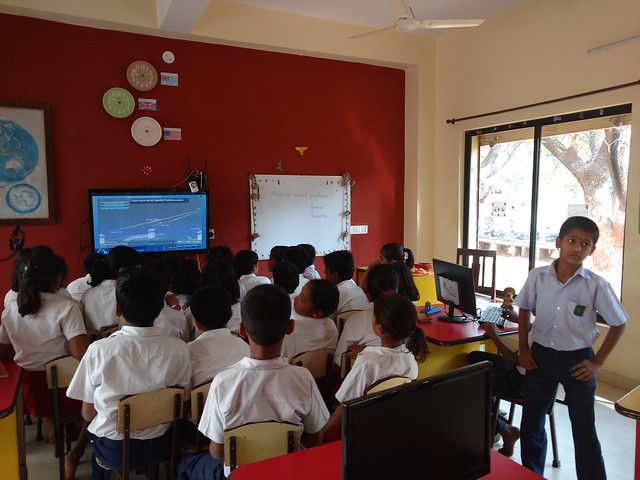The making of 'Moonlight in the Sea' | A guest post by Kartik Shanker, Dakshin Foundation
Posted by Pallavi Kamath on January 15, 2021New on StoryWeaver:
'Moonlight in the Sea' (written by Kartik Shanker, illustrated by Prabha Mallya, and published by the Dakshin Foundation) tells the story of Fatima who lives on an idyllic island in the Lakshadweep, watched over by Nihla, the moon. It introduces young readers to the underwater world of colourful corals, fascinating fish, mysterious manta rays, grizzled old turtles and dancing dolphins.
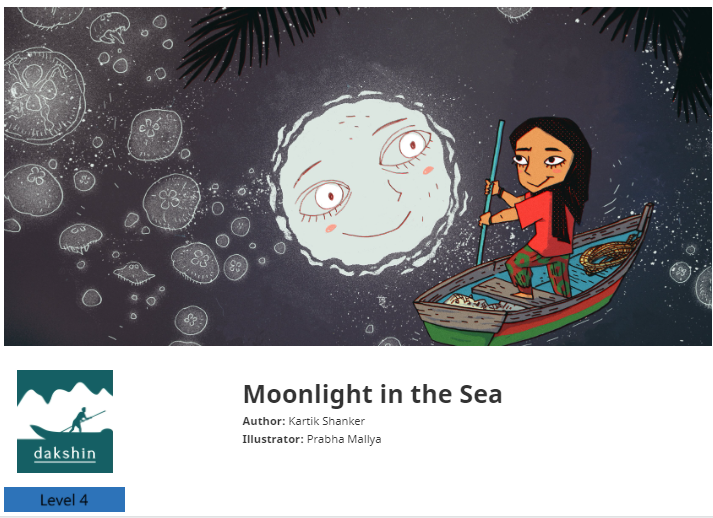
Learn more about the people and places that inspired the making of 'Moonlight in the Sea', in this blogpost by Kartik Shanker, author, ecologist, and founder trustee of the Dakshin Foundation:
As an aspiring wildlife biologist, you learn pretty early on not to expect National Geographic scenes when you visit a forest. It may take months to see your first elephant, years to see a tiger. It took me weeks of turtle walks to see my first olive ridley. But, put on a mask and a snorkel and stick your head under water at a good reef, and it looks pretty much like that last NGS show you watched.
I still remember the first time I went snorkeling in the Lakshadweep in 2001 – ‘the flurry of colour, the shock of shapes’. We were conducting sea turtle surveys there, and I spent every spare moment paddling around in the waters of the Kavaratti lagoon. A decade later, as part of Dakshin Foundation, we started a project on the tuna fishery in the islands. We monitored tuna using a participatory monitoring programme with the fishers, and one of our researchers, Mahima Jaini, conducted in-water surveys of baitfish. Around the same time, my student, Anne Theo had started her research on mixed species groups of reef fish.
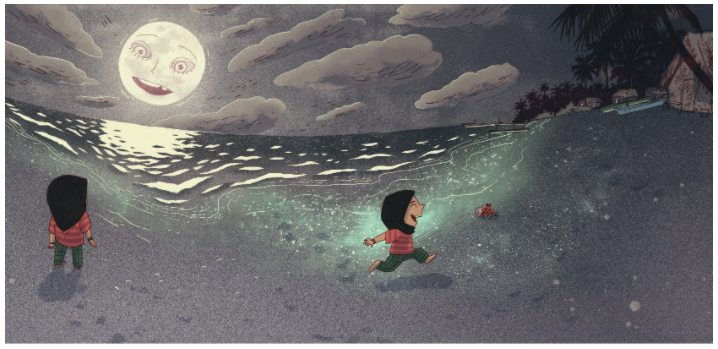
At Agatti, the two of them would use Jaffer’s fishing boat to conduct their dives. Throughout their time there, his support for their field work and dive surveys was invaluable. Jaffer looked after them as he would his family. In the evening, he and his wife would visit with their daughter Nihla, then an adorable 3-year-old. His boat was named after her, Nihla Fatima. The gentle ethos of the Lakshadweep, the still waters of the lagoons, the richness of its marine life, the solitary charm of Suheli all cried out for a story to be told.
Nihla inspired that story – about a little girl in the Lakshadweep, and the possibility that such girls could one day become marine biologists like Anne and Mahima.
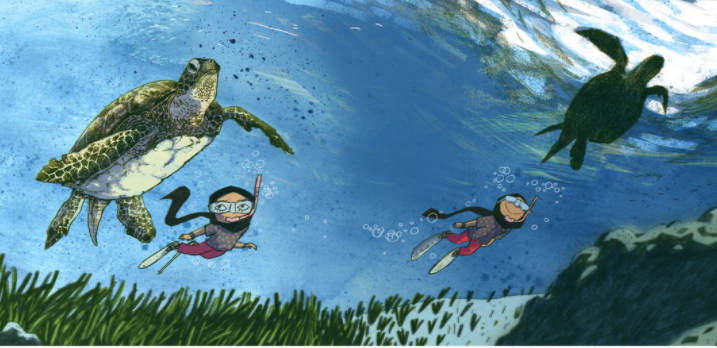
I visited them frequently – happy times were spent diving off Jaffer’s boat. One time, we dived off Bangaram, saw some sharks, and then ate the most delectable fish biryani cooked on the boat. Another time, the three of us made a trip to Suheli, an uninhabited island several hours by boat from Kavaratti. In 1979, my mentor, Satish Bhaskar, had spent 5 months there by himself during the monsoon to survey green turtles. Many of these memories found their way into the narrative.
And then Prabha Mallya made the story come alive with her amazing and evocative illustrations. In my story, Nihla, the moon was a quirky character; through Prabha’s illustrations, she became a co-star. My niece’s daughter Ariana, age 2, was heard to say ‘When I grow up, I wanna be Nihla moon!" I guess that says it all.
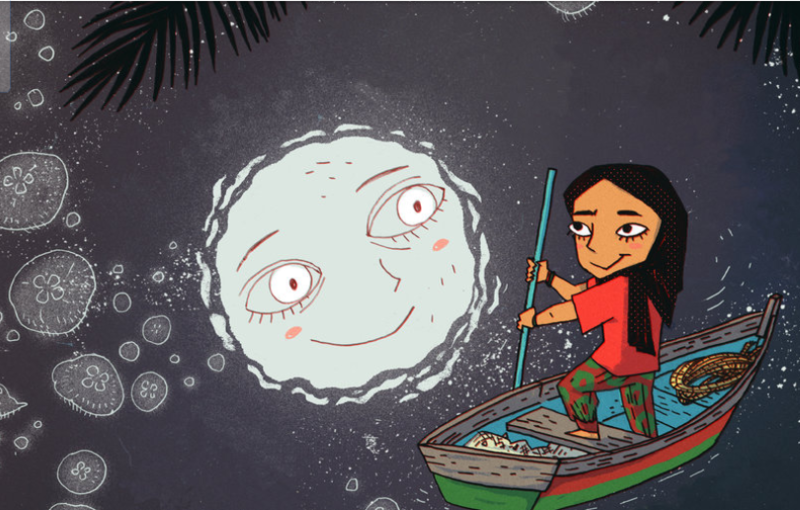
Click to read 'Moonlight in the Sea'
A big thank you, Kartik, Prabha and the Dakshin Foundation, for open licensing this wonderful book and making it available on StoryWeaver!
Illustrations in this post are by Prabha Mallya, from 'Moonlight in the Sea', written by Kartik Shanker, published by the Dakshin Foundation.
Kartik Shanker is a founder trustee of Dakshin Foundation. An ecologist by training, Kartik has interests in both mountain and marine systems. His work with marine turtles in the last 20 years has led to broader interests in coastal and marine conservation. Currently, he serves as an Associate Professor at the Centre for Ecological Sciences (CES), Indian Institute of Science (IISc.), Bangalore. In addition to academic research, he is also interested in strategies to improve environmental education and the public understanding of science. This interest encouraged Kartik to establish Current Conservation, a magazine that bridges conservation and art by bringing together research professionals, writers and artists from different parts of the world. He is the author of the book From Soup to Superstar, a historical account of sea turtle conservation in India. In his spare time, Kartik also seeks to distract young minds through children’s stories which include Lori’s Magical Mystery, Turtle Story, The Adventures of Philautus Frog, and Moonlight in the Sea.
Dakshin Foundation is a non-profit, non-governmental organisation. Their mission is to inform and advocate conservation and natural resource management, while promoting and supporting sustainable livelihoods, social development and environmental justice. They adopt interdisciplinary approaches in our research and conservation interventions, drawing from the fields of ecology, conservation biology, sociology, economics, and law. Their work aims at building community capacity for conservation and enhancing community engagement in environmental decision-making. Their goal is to promote ecologically and socially appropriate approaches to conservation and management in coastal, marine and mountain ecosystems in India.
comments (3)How to make storybooks in your Mother Tongue: a user writes for us
Posted by Remya Padmadas on February 20, 2017Saurashtra is a language spoken by a group that migrated from Gujarat two centuries ago to cities like Madurai, Chennai and Tanjore. The script for this language is no longer in use and while it does follow the Devanagiri system, many native speakers cannot read Hindi. The only languages available to write Saurashtram are English and Tamil. Pavithra Solai Jawahar asked us to add her mother language Saurasthra and has been busy translating stories and creating a book of rhymes in the language.
In recent times, I found myself to be very jealous of people who speak Indian languages like Tamil and Gujarati. The reason: There were these lovely publishers in India, who were bringing out beautiful books in regional languages for children and young adults. But there were none in my language, my mother tongue, Saurashtra. Belonging to a group of linguistic minorities, I believe when your language has a very limited literature for children, it is an injustice done both to the language and the children who miss out reading books in their mother tongue. And when you read in your mother tongue, you also take pride in your heritage. A sense of belonging, you can’t find elsewhere.
That’s why I started to translate children stories into Saurashtra. And it wouldn’t have been possible without the help of Pratham Books StoryWeaver. They graciously added Saurashtra onto the platform as a part of their Freedom to Read campaign.
There is something about a child’s imagination. You can never put a lid on it. It is unparalleled in a way, you and I, can’t imagine. So when I started to translate my first story, it was this fear that took over me. Will I do justice to this pure, boundless imagination of the child reading it? Also, Saurashtra is a dialect. A language whose script is in disuse. And so, I had to resort to transliterating Saurashtra into English. A language which would be easier to read for the children to read.
I have translated two books, as of now.
(Click on the above links to read these stories)
I have also created a “rhymes” book in Saurashtra, using illustrations from StoryWeaver. You can can read it here.
Now that I am able to create online story books in Saurashtra, my next challenge is to spread the word about it. And that’s where I discovered the next tricky thing about my mother tongue. Saurashtra has several regional variances, that my transliteration couldn’t cover. (The variation of Saurashtra I speak is different from my dad’s. Yes, that’s how it is!) I am in the process of getting inputs from the Saurashtra community, on how best this can be handled. Also, I now realise, that I should print these translations as physical books which can help engage children with the language better. You can expect more Saurashtra storybooks from me and if you know of any Saurashtrians or if you are one (Avo, avo!), please do share these books and spread the word.
You love your mother tongue. Let it live! :)
Pssst: Since you have read the whole blog, here is another interesting story book, I created with my spouse, for our nephew. It was about a certain SpaceBoy who jumps to the moon to dance with a dinosaur!
Be the first to comment.How Story Time Is Making Learning Fun for 30,000 Students in Maharashtra’s Govt Schools
Posted by Remya Padmadas on June 19, 2017In the hilly terrains of Phaltan, Satara district, Maharashtra a movement to seed the joy of reading in classrooms is being quietly seeded in 150 Zilla Parishad schools.
Pragat Shikshan Sanstha is an educational enterprise that supports schools, teachers and children in the district of Phaltan and other nearby areas. The organisation works with students through their own flagship school and after school programmes, and also trains teachers in good educational practices in government schools. By engaging researchers, government officials and the general public in an ongoing dialogue Pragat Shikshan Sanstha hopes to positively impact the education ecosystem.
“We are trying to impact the educational ecosystem by changing the image of ‘the child’ and ‘the teacher’ through excellent classroom practices, sound pedagogies, elements of classroom research and education for equality.” Manjiri Nimbkar, Secretary, Pragat Shikshan Sanstha.
Drop Everything and Read
One of Pragat Shikshan Sanstha’s areas of focus is setting up more libraries in the region. This, they felt was something that would not only benefit the schools in the area but also children from other nearby communities. The organisation felt that it was imperative to make books and read aloud sessions a part of their training offering to teachers. The idea was to get more teachers to use more books in their classrooms and libraries through read alouds and storytelling sessions.
Reading in so important in early childhood as books can free a child, and give them the opportunity to think and imagine. By helping children express themselves in varied ways, books encourage them to understand and empathise with the lives and experiences of those who are marginalised.
Pragat Shikshan Sanstha came across StoryWeaver - a digital repository of multilingual stories for children from Pratham Books and in it, discovered a source of stories in Marathi, the language of the region. All content on StoryWeaver is openly licensed under CC-BY4.0 and can be read, translated, downloaded, printed and shared for free. Through StoryWeaver, the organisation has access to many joyful stories in Marathi but without having to heavily invest in buying books regularly.
It’s story time!
Pragat Shikshan Sanstha curated a list of stories, in different levels across a variety of themes and topics and circulated it amongst the teachers who were being trained in using storytelling as a medium for language development.
These teachers also double up as librarians! The teachers choose from the circulated list the stories they think will work best for their students, downloaded them as per their class’s requirement and conduct read aloud sessions. Each library is equipped with a tablet and a projector which the teachers use to project stories off StoryWeaver. They also conduct various activities - art & craft, book reviews, games, skits etc around the books to help extend learning.
Pratham Books was fortunate to watch one of these wonderful sessions at a Zilla Parishad schools in the region. The classroom was equipped with a projector donated by a local badminton association and some computers (in working condition) from a corporate.
Bohra Bai, who teaches grades 2 and 3 in the school, first did a little warm up with the children before asking them to sit down. The story she had chosen that day was ‘Sam’s Christmas Present’ by Annie Besant and Alicia D’Souza in Marathi. Bohra Bai started from the cover page and urged the children to note everything that was there on the cover and predict what could the book be about. She got them to make connections, relate it to their own lives and pointed out sight words. Basically, everything you would expect a good teacher to do with a good book.
“We have regular sessions with teachers on how good read alouds are done, what are the different activities one can do with the books and the teachers value these training.”
When we took Bohra Bai aside to ask her a few question, young Diksha took over and continued to read the story aloud to her classmates, and did a tremendous job of it!
“Storybooks with illustrations help children imagine and understand better, along with learning about new cultures or things they don't see otherwise. For example with this book Sam's Christmas Present, they got to know about the festival of Christmas or the food that is eaten during Christmas as children from villages have never seen or eaten things like that.” shared Bohra Bai.
When asked about using technology in the classroom, she had this to say: “Projecting stories help catch children's attention better because this is new for them. Its interesting because it looks like TV to them.”
Stories can be an excellent tool in the classroom, an idea Bohra Bai strongly agrees with! “Stories really help children expand their vocabulary. For example, they get to know options of words in proper language that they use otherwise in their day to day lives, in dialects of that language. This really helps language development.”
A total of 150 Government schools in the Phaltan district have libraries & digital set up from PSS. About 30000 children from Grades 2 to 7, get to listen, read and enjoy stories in Marathi and Hindi.
“Going forward we hope to create more books for children with imaginative illustrations and help people understand the importance of illustrations. Create literature to help children understand and tackle issues and problems. Encourage children’s own creative writing.”
Be the first to comment.

